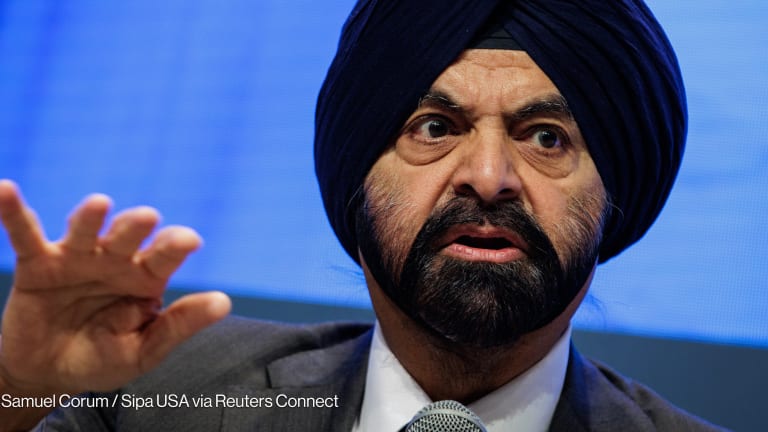World Bank's Banga wants 'largest of all time' IDA replenishment
"No amount of creative financial engineering will compensate for the fact that we just need more funding,” the World Bank president said at a midterm review of the bank's concessional financing arm for the poorest countries.
Donor governments must step up and make the next International Development Association replenishment the “largest of all time,” according to World Bank President Ajay Banga. The call comes as donor contributions to IDA, the World Bank’s concessional financing arm for the poorest countries, have flatlined in recent years. This is despite growing needs as low-income countries battle the lingering effects of the COVID-19 pandemic, debt distress, fuel and food price shocks, and the need to adapt to climate change. Set up in 1960 to offer grants and cheap loans to the world’s poorest countries, IDA is the world’s single largest anti-poverty fund, committing $42 billion in 2022 toward energy, transport, education, health, private sector development, and social protection projects. It is also the world’s only AAA-rated concessional fund and disperses funds in three-year funding cycles. Speaking at a meeting of donors and IDA borrower counties as part of the IDA20 Mid-Term Review in Zanzibar, Banga made it clear IDA needs more funding. The meeting also served as the unofficial fundraising kick-off for IDA21, the next cycle. The bank now has a year to fundraise for IDA21 ahead of the pledging conference in December 2024. “We are pushing the limits of this important concessional resource and no amount of creative financial engineering will compensate for the fact that we just need more funding,” Banga said in a speech Wednesday. “This must drive each of us to make the next replenishment of IDA the largest of all time.” Banga’s presence at the meeting was itself significant; he is the first World Bank president to attend an IDA midterm review, flying in straight from negotiations at the 28th United Nations Climate Change Conference, or COP 28, in Dubai. However, he stopped short of calling for IDA to be tripled by 2030 — something recommended in a 2022 report by the influential Independent High-Level Expert Group on Climate Finance which recommended tripling the multilateral development bank’s financing in order to address the world’s growing crises. IDA20 raised $93 billion. Experts welcomed Banga’s commitment to IDA. “Banga’s presence in Zanzibar is the message. IDA needs a big donor infusion and he’s going to throw his political weight behind it,” Clemence Landers, a senior policy fellow at the Center for Global Development, told Devex. But some think he is not ambitious enough. “Ajay Banga is right that IDA needs to be much bigger, better and more efficient to provide the support countries need to fuel a new era of sustainable development and turn the tide on the climate crisis,” Amy Dodd, policy director of development economics at ONE Campaign, wrote to Devex. “If Banga is serious about building a world free from poverty on a liveable planet then he must listen to the calls from African Leaders and the G20 independent experts who called for a tripling of IDA financing by 2030,” Dodd continued. “Reaching that goal is going to take serious ambition and commitment. Early calls for ‘practicality’ are pushing us to lower that bar when we’ve barely started,” Dodd told Devex. More donor funding While on the surface, IDA has a strong fundraising track record — it increases its capital every round — this masks stalling donor contributions. The majority of the increases are driven by the fund’s ability to raise money from capital markets by borrowing against its loan portfolio, which it started doing in 2017. It also gets money from reflows from old loans. Of the record $93 billion raised for IDA20, which runs until June 2025, only $23.5 billion came from donors. However, with high interest rates and increasing numbers of countries in debt distress, IDA’s ability to raise funds through capital markets and reflows is likely to be reduced, increasing the need for donor funding. Banga said it was crucial to “turn the tide” on declining donor contributions to IDA and increase them by between 20%-25%. This will enable the bank to “work even harder” to increase IDA’s leverage ability beyond 4 to 1, he said during the Zanzibar event. “Especially in times of high interest rates it would be a real mistake to try to juice the replenishment numbers by including market borrowing like they did last time [at IDA20],” Charles Kenny, a senior fellow at the Center for Global Development, told Devex over email. “Borrowing off IDA’s balance sheet to finance more lending today comes at the cost of less lending tomorrow — and a lot less when interest rates are high. We need more cold hard cash,” he added. ‘Reimagining’ IDA The president also hinted at plans for “reimagining concessional finance.” Traditionally, IDA has been funded by sovereign governments, but the bank is looking to open it up to philanthropists and other donors, he said. “We need everyone — donors, shareholders, philanthropies — to step up, join us, and bring their ambition to the fight, otherwise the potential for IDA will never be realized,” Banga said. Historically, IDA’s top donor countries have been Japan, the United States, Germany, France, China, Canada, Sweden, the Netherlands, the United Kingdom, and Italy. In terms of donors increasing contributions, Saudi Arabia signaled its intention to step up its support for IDA21, Ryadh Mohammed Alkhareif, deputy minister of international affairs, said during a panel session as part of the Zanzibar event. Reform Banga also talked about the need to reform IDA to make it “more approachable, accessible, and understandable,” including by reducing the “opaque web of bespoke funds” that recipient governments have to navigate. “If we could create fewer funds with more flexibility, streamline our standards, or bring uniformity to the application process — we can give back time,” Banga said. Banga may be referring to ‘IDA windows’ — pots of money that are earmarked for specific activities, such as private sector development — but also trust funds and Financial Intermediary Funds, of which the bank has many. Kenny welcomed Banga’s plans to reduce earmarked funds, describing the IDA windows as a “mistake” since they “reduce flexibility” and cater to donor “pet projects” when IDA’s lending should be driven by demand from recipient countries. Furthermore, it is more cost-effective for donors to donate through IDA rather than trust funds since IDA has a one to four leverage ratio, meaning $1 invested in IDA can mobilize $4 in lending to borrower countries, Dirk Reinermann, director of IDA resource mobilization, told Devex. Reinermann said he is optimistic the bank can deliver a record-breaking IDA in the coming replenishment round. “We have never felt so much wind in our sails so early in a replenishment as we do now in terms of political support. We are riding on a wave right now,” he said. Update, Dec. 7, 2023: This article has been updated to clarify Saudi Arabia’s donor status and that IDA increases its capital.
Donor governments must step up and make the next International Development Association replenishment the “largest of all time,” according to World Bank President Ajay Banga.
The call comes as donor contributions to IDA, the World Bank’s concessional financing arm for the poorest countries, have flatlined in recent years. This is despite growing needs as low-income countries battle the lingering effects of the COVID-19 pandemic, debt distress, fuel and food price shocks, and the need to adapt to climate change.
Set up in 1960 to offer grants and cheap loans to the world’s poorest countries, IDA is the world’s single largest anti-poverty fund, committing $42 billion in 2022 toward energy, transport, education, health, private sector development, and social protection projects. It is also the world’s only AAA-rated concessional fund and disperses funds in three-year funding cycles.
This story is forDevex Promembers
Unlock this story now with a 15-day free trial of Devex Pro.
With a Devex Pro subscription you'll get access to deeper analysis and exclusive insights from our reporters and analysts.
Start my free trialRequest a group subscription Printing articles to share with others is a breach of our terms and conditions and copyright policy. Please use the sharing options on the left side of the article. Devex Pro members may share up to 10 articles per month using the Pro share tool ( ).
Sophie Edwards is a Devex Contributing Reporter covering global education, water and sanitation, and innovative financing, along with other topics. She has previously worked for NGOs, and the World Bank, and spent a number of years as a journalist for a regional newspaper in the U.K. She has a master's degree from the Institute of Development Studies and a bachelor's from Cambridge University.








